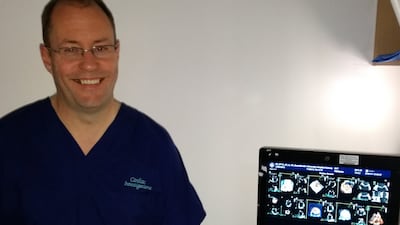Dr Khine Hay Mar was the only doctor at a hospital in Mese – a town in Myanmar, near the border with Thailand. During her time as the sole physician there, in order to save lives, she relied as much on her ability to scrounge supplies as she did her medical expertise.
Dr Khine recalls a time when she was treating a woman in labour, with no power in the hospital, no anaesthetic in stock, and just one nurse to assist. Believing the woman and child would die if she did not act quickly, she went with her instincts and did all she could think to do.
She called for help from a military doctor post nearby, found batteries to power the lights, and found local anaesthetic drugs to apply to the woman’s spine. Then, she began the operation.
Luckily, both mother and baby survived.
However, this was not always the case, and Dr Khine was regularly frustrated at how limited she was in her ability to help patients due to lack of provisions. She says that no matter how well-trained you are, knowledge is not enough, and saving lives is impossible without the necessary tools and equipment.
Despite 40 million new health worker jobs set to be created worldwide by 2030 – according to the World Health Organisation – there is still an expected shortfall of up to 18 million. The largest deficit of health workers (in a 2013 report) was in South-East Asia, where Dr Khine is based. The shortfall there was 6.9 million.
In the coming years, this huge shortage is expected to be felt all over the world, particularly in low to lower middle income countries.
Population growth and changing demographics are expected to contribute to the future gap in numbers needed versus numbers available – as the concentration of healthcare workers will be in higher income areas, leaving those who need it most, without.
Over the last decade, there has been a 60 per cent increase in the number of migrant doctors and nurses working in Organisation for Economic Co-operation and Development (OECD) countries – generally, the wealthiest countries in the world – further contributing to the uneven distribution of workers. This ensures that there are fewer healthcare professionals available where there is a greater need. And that need is probably greatest in many parts of Africa.
Marjorie Mukukula is a university lecturer and former midwife from Zambia.
Once, while travelling to a rural area to pre-test Community Health Assistant Supervisory tools, she and her group found themselves assisting a nurse attending to a woman in labour.

“We could see that the woman was losing a lot of blood and was going into shock,” says Ms Mukukula. “The nurse was eager to assist the patient, but lacked clinical skills and didn’t know how best to access help from health workers in bigger health facilities where the patient should have been referred for specialised care. Time was running out.”
Having started resuscitating the patient, they contacted an obstetrician and were advised to move the patient to the nearest referral health facility, and the patient was evacuated there as soon as was possible. “This experience completely changed my thinking regarding the support nurses and their frontline teams in rural facilities should receive and ultimately this incidence contributed to significant insights in the way the Certificate in Leadership and Management Programme in Zambia is delivered.”
While the lack of vital skills and tools is responsible for failing medical care in some parts of the world, social issues can also contribute to the inconsistencies in healthcare in some parts of the world.
Rushanna Gallow, a South African paramedic, works in a station that services the Cape Flats, a part of Greater Cape Town which was long known as “apartheid’s dumping ground”.

The Cape Flats have very high levels of gang-related violence, with ambulances and paramedics frequently caught in the crossfire. It is becoming increasingly difficult for paramedics and first responders to attend to those in need of urgent care when they themselves are being attacked.
Maria Valenzuela, a community health worker in Phoenix, Arizona, has spent her life trying to help the most vulnerable people in her community get access to healthcare.
“In 1979, my mother brought me from Mexico to the United States – young and determined to make a better living for herself and her 6-year-old daughter,” she explains. “However, after several setbacks, by age 13, I ended up in the foster system. My own success in making it productively through my childhood is a result of determination but also luck. That experience has given me a deep understanding of the power of education and access to health services, and it is also why 17 years ago, I started working as a community health worker in low-income communities for an organisation called Esperança.”
Dr Khine, Marjorie, Rushanna and Maria are some of the health workers from around the world who will be telling their stories at the Storytelling Evening as part of the Fourth Global Forum on Human Resources for Health, on Monday, November 13th in RDS, Dublin. One thousand delegates will be present to discuss how to combat the future workforce shortage, including retention, training and migration.
The “storytellers” also include a cardiac physiologist in University Hospital, Galway. Paul Nolan will talk about the “stress test” – where the patient wears a heart monitor while walking on a treadmill – he performed on a man right at the beginning of his career. Soon after the test began, the patient collapsed and died.
The patient’s heart specialist arrived to find Paul was in shock. He sat Paul down, made him a cup of tea and went through what happened. He explained this was something that may have happened at any time to this man, and that Paul had not done anything incorrectly.

Paul said this made it possible for him to go home, to reconcile himself to what had happened – and to come back to work, not just the next day, but every working day for the next 20 years.
The forum – which will then run from November 14th-17th – is assembled by Trinity College Dublin, Health Service Executive (HSE), Irish Aid, Department of Health, World Health Organization (WHO) and Global Health Workforce Network.


















